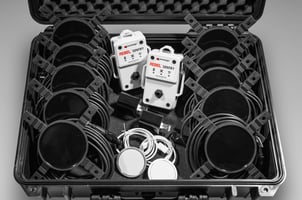In 2021, Wavelogix partnered with INDOT and Purdue University to enhance road and bridge...
Concrete Testing Costs in Construction Projects – What to Expect & How to Cut Expenses
Concrete strength testing is a critical part of every construction project, ensuring structures are safe, compliant, and built to last. However, traditional testing methods—especially when reliant on third-party labs—can significantly increase project costs and timelines. Understanding the full scope of these expenses, and how emerging sensor technology can cut them, is essential to improving efficiency and profitability.

Common Concrete Testing Methods and Their Costs
Here’s a breakdown of the most common strength testing methods and their associated costs:
1. Cylinder Break Tests (ASTM C39)
- Cost per set: $100–$200 (3 cylinders per set)
- Add-on fees: Technician time, transport, lab analysis, and reporting
- Total cost per pour: $300–$600+
- Hidden costs: Delays while waiting for results, conservative overdesign, and costly re-pours if breaks fail or are missed
2. Core Sampling
- Cost per core: $500–$1,000
- Use case: Rarely planned—usually required when issues arise or as a final verification step
- Challenges: Destructive, reactive, expensive, and time-consuming
3. Concrete Sensors
- Cost per sensor: $100–$250
- Installation: Embedded during pour, no need for post-install work
- Data delivery: Real-time strength and temperature tracking, accessible remotely
- Overall savings: Lower cost than lab testing when considering fewer delays, better scheduling, and reduced risk
The Real Cost of Testing: Time, Labor & Uncertainty
Concrete strength needs to be tested at numerous stages of the curing process including early checks, standard industry milestones, and before major structural loads. And the testing method you choose can greatly affect the overall cost. Traditional testing methods don’t just cost money—they can also cost time. And any delays waiting for break results create a ripple effect:
- Extended labor hours
- Increased equipment rentals
- Scheduling disruptions
- Risk of failed breaks and rework
Moreover, lab tests are only snapshots—they don't reflect in-place concrete performance, which can differ significantly due to site-specific variables.
And when breaks go bad, the liability costs are real. Failed strength tests can lead to re-pours, work stoppages, liability claims, and sometimes legal exposure. The cost of one bad break could easily reach $10,000–$50,000+, depending on project scope and delays.
How to Cut Concrete Testing Costs Without Sacrificing Quality
To avoid these pitfalls, contractors and engineers are turning to real-time concrete strength sensors like REBEL by Wavelogix. Here’s how they help cut costs and reduce risk:
- Reduce cylinder sets per pour – Use minimal break tests for verification, not total dependency
- Eliminate lab delays – Instant strength readings mean no more waiting days to move forward
- Optimize labor and equipment use – Knowing actual strength lets you schedule crews and equipment with precision
- Avoid costly rework – Real-time data catches issues before they become failures
Smarter Testing = Lower Costs + Greater Control
Concrete testing will always be essential—but overspending doesn’t have to be. If you combine traditional methods with modern sensor technology, you get both compliance and control at a lower cost. Cutting-edge sensors like Wavelogix’ REBEL provide real-time, in-place data that eliminates guesswork, cuts delays, and helps ensure your project runs smoothly and profitably.
Concrete Testing Methods at a Glance
|
Method |
Cost |
Timing |
Drawbacks |
Best For |
|
Cylinder Breaks |
$300–$600+/pour |
1–7+ days |
Delays, added labor, not in-place data |
Validation & regulatory compliance |
|
Core Sampling |
$500–$1,000+ |
Post-pour |
Destructive, expensive, reactive |
Diagnosing problems |
|
Concrete Sensors |
$100–$250 each |
Real-time |
Requires pre-planning |
Reducing lab reliance & delays |
Ready to Save Time and Money?
Concrete strength sensors like REBEL from Wavelogix are proven to reduce costs, limit liability, and keep projects moving.
Want to learn more? Schedule a demo or explore our case studies today.
Contact Us




